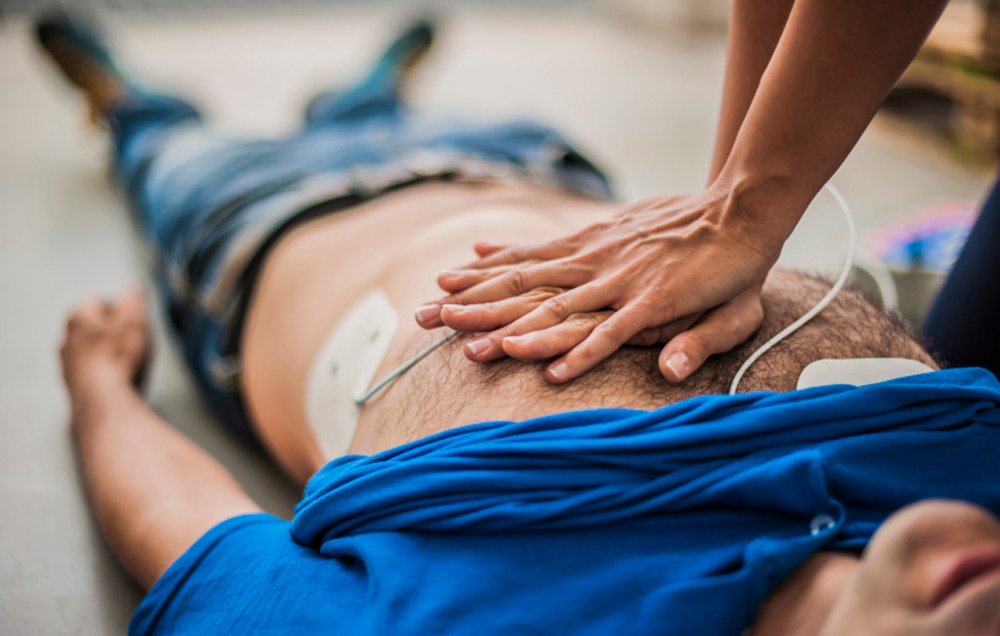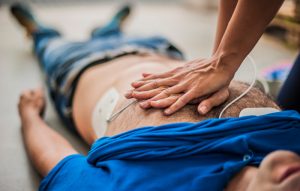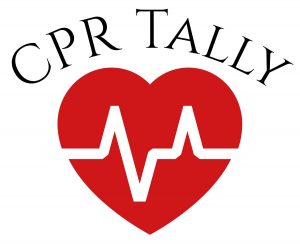
It’s always better to do something, then nothing! With 70 percent of all out-of-hospital cardiac arrests happening at home, if you’re called on to perform Hands-Only CPR, you’ll likely be trying to save the life of someone you know and love. Hands-Only CPR carried out by a bystander has been shown to be as effective as CPR with breaths in the first few minutes during an out-of-hospital sudden cardiac arrest for an adult victim
At anytime, it could be possible that you are the first responder in the midst of a medical emergency. As many as 300,000 people every year experience cardiac arrest in a public setting, where administration of CPR given by a bystander is very important.
Cardiac arrest can occur as a result of an irregular heart rhythm, respiratory arrest, choking, drowning, and trauma. If you’ve witnessed someone collapse, ensure that the scene is safe and direct others around to call 9-1-1 and retrieve an AED. AED’s are commonly located in chain restaurants, gas stations, gyms, schools, and medical facilities.
After directing others for help, scan the body for breathing. If there are no signs of breathing, begin to administer Hands Only CPR. Hands-Only CPR consists of only chest compressions with no additional breaths. According to the American Heart Association, effective chest compressions have proven to be as beneficial as CPR with breaths. Due to the rise and fall of the chest during compressions, enough oxygen circulates throughout the body. Not only do compressions circulate a small amount of oxygen, but blood as well.
breaths. According to the American Heart Association, effective chest compressions have proven to be as beneficial as CPR with breaths. Due to the rise and fall of the chest during compressions, enough oxygen circulates throughout the body. Not only do compressions circulate a small amount of oxygen, but blood as well.
By pushing on the center of the victim’s chest, blood is being pumped to vital organs and back into the chambers of the heart. While giving chest compressions, one is buying time for the arrival of an AED or emergency services. Chest compressions maintain a mechanical, steady rhythm of the heart, but an AED can restore the hearts natural rhythm.
If you do not know how to administer CPR with breaths, don’t be afraid to act in an emergency; your actions can only help. Any attempt at CPR is better than no attempt. If you see an unconscious, unresponsive adult, call 9-1-1 and push hard and fast in the center of the chest to the beat of the classic disco song “Stayin’ Alive.” This song, and other songs with a rhythm of 100 to 120 beats per minute, mimic the rate you should push on the chest during CPR.
CPR is a psychomotor skill. The AHA continues to recommend that you take a CPR course to practice and learn the skills of CPR, including giving high-quality chest compressions. People who have had CPR training are more likely to give high-quality chest compressions and are more confident about their skills than those who have not been trained (or have not trained in the last 5 years).
Sign up for a class at CPR Tally, Tallahassee’s leading premier training site for the American Heart Association. Our website is www.cprtally.com with upcoming classes every week or give us a call at (850) 559-1678.
